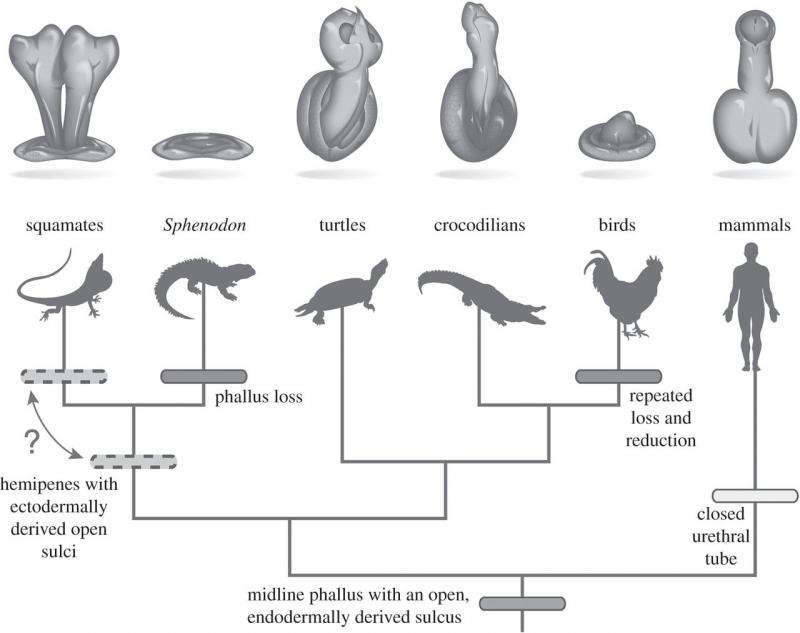October 28, 2015 report
Old tuatara slides show genital swelling in last common ancestor of vertebrates

(Phys.org)—A trio of researchers with the University of Florida has found evidence of genital swelling in a tuatara embryo from over a hundred years ago and it offers evidence that penile evolutionary development in vertebrates only occurred once. In their paper published in the journal Biology Letters, Thomas Sanger, Marissa Gredler and Martin Cohn describe how they created 3D images of the endangered reptile from old slides found in a museum and what they learned as a result.
Among evolutionary scientists there has been a debate for quite some time regarding the evolutionary history of the penis in vertebrates—some suggest it only occurred once and the various types of penises that exist today in different species evolved from it, while others suggest each evolved separately. To help settle the debate, scientists have been looking for a common ancestor with a really long history—if it had a developed penis, that might suggest that all the other penises that developed in vertebrates, evolved from a common ancestor. In this new effort, the researchers turned to the tuatara as an example of that ancestor; a creature native to New Zealand that looks like a lizard but is not—they diverged from other reptiles approximately 250 million years ago.
But the team was not able to study tuataras directly because they are endangered and take a very long time to reproduce—instead, they cleaned up and photographed old slides made from slicing tuatara embryo samples nearly a hundred years ago by Arthur Dendy. The slides had been made from four embryos, one of which was just the right age for the study—despite being stored in a museum for over a century, they were still in good enough condition to allow for study. After sorting out the right slides and taking pictures, the photographs were then converted to a 3D model which showed genital swellings, a precursor to penis development in many vertebrates. In the tuatara, the developments do not mature, like many modern bird species, they cease developing, thus adults have no penis. But the swellings clearly show the possibility, which the team suggests, offers a strong argument to the case of the penis developing from a common ancestor.
More information: Resurrecting embryos of the tuatara, Sphenodon punctatus, to resolve vertebrate phallus evolution, Biology Letters, Published 28 October 2015.DOI: 10.1098/rsbl.2015.0694
Abstract
The breadth of anatomical and functional diversity among amniote external genitalia has led to uncertainty about the evolutionary origins of the phallus. In several lineages, including the tuatara, Sphenodon punctatus, adults lack an intromittent phallus, raising the possibility that the amniote ancestor lacked external genitalia and reproduced using cloacal apposition. Accordingly, a phallus may have evolved multiple times in amniotes. However, similarities in development across amniote external genitalia suggest that the phallus may have a single evolutionary origin. To resolve the evolutionary history of amniote genitalia, we performed three-dimensional reconstruction of Victorian era tuatara embryos to look for embryological evidence of external genital initiation. Despite the absence of an intromittent phallus in adult tuataras, our observations show that tuatara embryos develop genital anlagen. This illustrates that there is a conserved developmental stage of external genital development among all amniotes and suggests a single evolutionary origin of amniote external genitalia.
Journal information: Biology Letters
© 2015 Phys.org




















